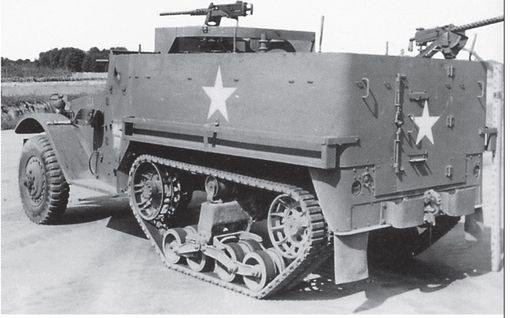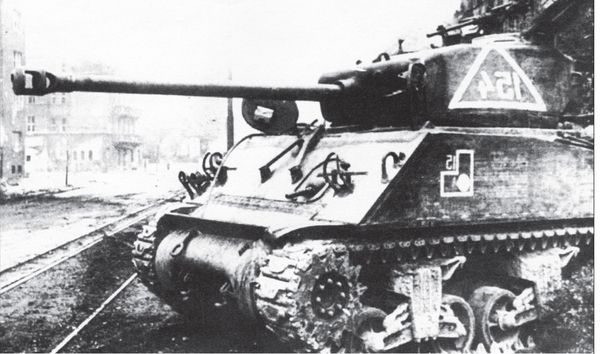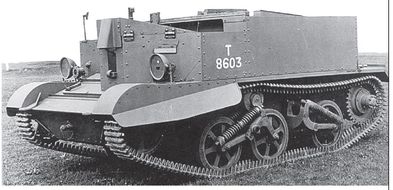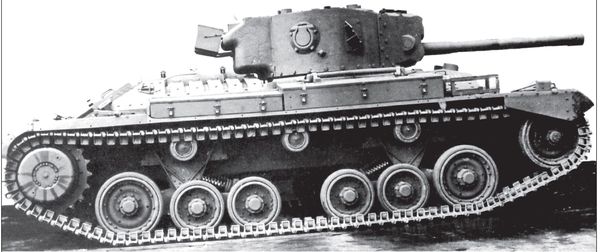Warszawa II (34 page)
Authors: Norbert Bacyk

Production period:
1941 â 1945
Manufacturer:
White, Autocar
Tonnage:
9 to 9.3 tonnes
Crew:
3 + 10
Length:
6.32 meters
Width:
1.96 meters
Height:
2.31 meters
Track width:
30 cm
Ground clearance:
40 cm
Motor:
unavailable
Engine capacity:
128 HP â rpm unavailable
Fuel capacity:
unavailable
Maximum speed:
72 km/h
Maximum range:
345 km
Armament:
1Ã 0.50 cal MG
2Ã 0.30 cal MG
Ammunition quantity:
0.50 cal -?
0.30 cal -?
Armour strength:
Hull frontal:
12 mm
Hull sides:
8 mm
Hull rear, roof, floor:
8 mm
Turret fronl:
unavailable
Turret sides:
unavailable

The USA's answer to the German 251: A traditionally built half-track with a front-mounted motor and combat space at the rear. Swift, robust and dependable, it was a weakly armoured but was nonetheless popular. Built in several special versions, a total of approximately 56,000 these half-tracks were produced during WWII. The Soviets received approximately 1,400 under the lend-lease programme.

The USA's first true self-propelled anti-tank gun or “tank-killer”. The vehicle was built on the chassis of the M4A2 or M4A3 but with lighter armour and a new turret which had a better gun than the original, a 3-inch M7. Overall not a particularly successful construction; though it certainly had a better gun to penetrate the front hulls of German tanks, as opposed to the M4's 75mm, but with weaker armour, manual turret rotation, and without a machinegun in the turret to protect against infantry attack. Nonetheless, it remained in service until the M18 and M36 came on line in 1944. In total, nearly 7,000 M10s were built, of which the Soviets received 52 â almost all of which saw service with the 1st Belorussian front.
Production period:
1941 â 1944
Manufacturer:
White Motors
Tonnage:
6 tonnes
Crew:
4
Length:
5.61 meters
Width:
2.03 meters
Height:
1.98 meters
Track width:
unavailable
Motor:
unavailable
Engine capacity:
97 HP â rpm unavailable
Fuel capacity:
unavailable
Maximum speed:
92 km/h
Maximum range:
260 km
Armament:
1Ã 0.50 cal MG, 2 â 3Ã0.30 cal MG
Ammunition quantity:
0.50 cal - ?
0.30 ca - l?
Armour strength:
Hull frontal:
12 mm
Hull sides:
8 mm
Hull rear, roof, floor:
8mm
Turret front:
unavailable
Turret sides:
unavailable
The USA's and the rest of the world's most common tank during WWII. Approximately 50,000 vehicles were built during the war years. (!!!) The frontal hull was sloped but not the side hulls which didn't add value to the vehicle's protection. In addition, the Americans typically had a white star painted the tank's sides, enabling the enemy to pinpoint their sights. Moreover, this vehicle caught fire so easily that it was nicknamed the “Ronson lighter” and, as cited earlier, in the beginning of the war it was too lightly armed. Nonetheless, it was a robust tank and the most produced. The Soviet's received 4,000 M4's through the Lend-Lease programme.


Production period:
1942 â 1945
Manufacturers:
Lima Locomotive
Works, Chrysler
Tonnage:
28.5 tonnes
Crew:
5
Length:
5.89 meters
Width:
2.62 meters
Height:
2.74 meters
Track width:
43 cm
Ground clearance:
40 cm
Motor:
9-cyl Continental R975C1
Engine capacity:
350 HP at 2,400rpm
Fuel capacity:
662 litres
Maximum speed:
35 km/h
Maximum range:
190 km
Armament:
1Ã 7.5 cm M3, 1Ã 0.50 cal MG, 1Ã 0.30 cal MG
Ammunition quantity:
7.5 cm â 97 shells
0.50 cal â 300 rounds
0.30 cal â 4,750 rounds
Armour strength:
Hull frontal:
51 mm
Hull sides:
38 mm
Hull rear, roof, floor:
19 mm
Turret front:
85 mm
Turret sides:
25 â 50 mm
Perhaps the most British of all of the military inventions during WWII; the Bren carrier. No other country used a track driven transport vehicle of its size and to such an extent as Britain did. Over 50,000 were built between 1939 and 1945. Their areas of application were widespread and it was very popular among the troops. The Russians used them primarily as reconnaissance vehicles.

Production period:
1939 â 1945
Manufacturer:
Vickers
Tonnage:
3.6 tonnes
Crew:
2 + 4
Length:
3.76
Width:
2.11 meters
Elevation:
1.60 meters
Track width:
20 cm
Ground clearance:
25 cm
Motor:
unavailable
Engine capacity:
85 HP
Fuel capacity:
unavailable
Maximum speed:
53 km/h
Maximum range:
unavailable
Armament:
1Ã 7.92 MG
Ammunition quantity:
7.92 mm â 600 rounds
Armour strength:
Hull frontal:
12 mm
Hull sides:
6 mm
Hull rear, roof, floor:
6 mm

Britain's most common infantry support tank during WWII. The vehicle was primarily designed for close infantry support. This meant that was not equipped with the strongest of motors. Hence, it wasn't capable of moving at high speed and, at the beginning of the war, it was weakly armed. Despite this, it proved to be a popular tank, above all with the Red Army, as it didn't require much maintenance.
Production period:
1943 â 1945
Manufacturer:
Chelyabinsk
Tonnage:
45/46 tonnes
Crew:
5
Length:
9.58/9.18 meters
Width:
3.07 meters
Height:
2.48 meters
Track width:
47 cm
Ground clearance:
50 cm
Motor:
W2-IS diesel
Engine capacity:
600 HP at 2,000 rpm
Fuel capacity:
550 litres
Maximum speed:
37 km/h
Maximum range:
220 km
Armament:
1Ã 12.2 cm D25S Howitzer (122),
1Ã 15.24 cm ML20 Howitzer (152),
1Ã 12.7 mm MG DShK (both)
Ammunition quantity:
12.2 cm â 30 shells
15.24 cm â 20 shells
12.7 mm â 250 rounds
Armour strength:
Hull frontal:
90 mm
Hull sides:
90 mm
Hull rear, roof, floor:
25 mm
Turret front:
90 mm
Turret sides:
90 mm
By Martin MÃ¥nsson
T
he Swedish volunteer SS-Untersturmführer Gösta Borg was one of the few Swedish volunteers present in Warsaw during the bloody Uprising of 1944. As war-correspondent for the SS-Standarte “Kurt Eggers” Borg reported on the fighting in Warsaw's from its urban centre. He was also present in the city quarter of Praga where the IV.SS-Panzer-Korps clashed with the 1st Belorussian Front. The fighting in and around Praga was incredibly intensive and there were heavy losses on both sides. Officially, it is usually claimed that the Red Army halted outside of Warsaw for military reasons. It is well known that Stalin had no intention of assisting the Polish Home Army under General “Bór” against the Germans during the Uprising and, as this book shows, the Red Army was anything but inactive in areas just outside Warsaw. The IV.SS-Panzer-Korps under SS-Obergruppenführer Herbert Otto Gille effectively halted the Soviet offensive, but at the cost of incredible losses in equipment and human lives.
After the war, Gösta Borg wrote a book titled “Det Röda Massanfallet” i.e. ”The Red's Massed Attack” in which he recounts some of his experiences from the Warsaw area during the months of July and August, 1944. On pages 20 and 23 of this book, Borg describes the situation at the front and his impressions from the bloody battlefield.
Â
“The Red's Massed Attack” by Gösta Borg:
Â
“In Poland July â August, 1944”
Â
During July and August of 1944, the Red Army pressed hard against the German positions at Radzymin, east of Warsaw. At times, the two badly tattered German panzer-grenadier divisions had up to 30 Red divisions opposing them.
Â
Things are nervous during the afternoon. To the east the dust clouds rise, yellow-brown clouds mushroom in the air
and on the ground. The Soviet frontline infantry is active â. Fighting rages at several points: In one district, an attack is underway. The corps' staff know the defender's instructions: reconnaissance pilots deliver their photos: the roads on the enemy's side are filled with convoys, every wooded area is bristling with panzers, infantry and heavy formations. Artillery is heaved from the road, barrel by barrel and a flood of all types of vehicles loaded down with shells, shells and shellsâ¦
During the evening, a counter-attack is launched to lighten the pressure on an important position. Prisoners are taken from a new enemy division, defectors report the number of divisions double the number that had been assumed: “The road from Bialystok is filled with artillery, guards and T-34s, many “Josef Stalin” and “Stalin's organs”.(Katjusha rocket-launchers).
During the night, the pressure mounts; beginning at 2400 hours, new artillery units bombard road crossings, battery positions, and command posts; one battalion reports that a rye field is filled to bursting with stalking infantry. Our own troops are wide awake, digging and improving, banding ammunition, priming hand grenades, stacking shells and panzer “fists,” improving camouflage, reads a field post card.
0300 hours. At staff headquarters, they wait, not yet, not yetâ¦. then a gigantic flame appears over the eastern horizon, it's like looking at a forest bending before a storm. A curtain of shells rush up towards the morning sky. At last! â The tension relaxes on everyone's face. It has begun â from the closest sniper trench, reaching six miles to its rear, rages a hurricane of fire.
Â
How do things seem at the front?
Â
What does a combat area look like on given day when a massive attack shakes the earth?
“The landscape shakes” because the ground tremors within a radius of six miles. Let's go there and look around!
Â
“The landscape south of the Bug is rife with hills, patches of pine forest, and clusters of grey houses surrounded by picket fences overgrown with ivy and kitchen plants. The earth is extremely sandy, the roads mostly sand-filled, meandering brooks; in August, the rye stands at the height of a man. Between the rich soil in the south (black earth with leafy forests) and the River Bug in the north runs a concrete road from Bialystok to Warsaw. Along that road presses a massive collection of Soviet divisions; guards-artillery, guards-panzers, infantry and cavalry supported by corps units from the army artillery. The sky is clear and the heat strong, as the heavy traffic causes dust clouds to rise that are constantly renewed. West of Modlin an unending thunder can already be heard â it increases with every kilometre, soon houses are shaking. At the Bug-crossing the din is already all pervasive: It has enveloped the terrain; the sides of the car shake, it's necessary to shout. Anti-aircraft guns spray grey/black explosive clouds towards the blue sky, the aluminium glitters as the wing of the target passes over, the screeching wind penetrates the eardrums. The din continues to rise, the river bank lies behind us. A car hurries on, passing an ammunition vehicle which, alone and at great speed, drives in under covering fire, meets others, covered with thumb-thick layers of dust, often a pair of legs dangle over the edge. Ambulances, blown-apart tanks. In front of us, a traffic jam, traffic police and ---- it howls in over us â No, in front of us, hands grab hold of tucked-in heads, the earth groans, trees are cut down, heat and dust â and then, too soon, another crash, but this time in a cluster of houses out on the left.
Â
Long-range enemy artillery lays siege to the terrain with heavy, disruptive bombardment â on the road, a car burns â black clumps, the stink of burning flesh, blood, rags, sun, dust â and even this soon, flies. The first wounded: bloody bandages, open combat-jackets, day-old beard stubble, eyes strangely open â the lightly wounded on their way back.
Camouflaged tanks stinking of earth, oil, gas â in front of us a drawn-out crash â the brutal impact of shells fired from enemy heavy-artillery units.
We pass a grove of trees, they are on fire, the screech of falling bombs â on the roadside someone lies dead â in front of us, hell opens its arms; a kilometre-wide, a burgeoning grey/ black cloud spreads out over the terrain, covers it, slamming up tree groves, and hills, stream-filled ravines, and huddles of grey/white dwellings. In the black/grey burn villages, yellow-red â a mixture of earth, dust and explosive gases, fragments of life and matter obliterate the border between earth and the heavens â a roaring monster heaves itself out over the front.
In and throughout all of this â move people, tanks, vehicles. But this is only the anteroom â there in front, men hug their weapons, aim, shoot, kill or be killed.
A village burns, the smoke washes over the field, we press down in a ditch, in front and above us fly black, ground-strafing planes. Machinegun-fire, short hollow screams, drawn out salvos â directed at us! Aircraft guns and rockets! The potato field is ripped up, earth and potato-haulm spray in string-straight lines. We press harder against the ground, bombs â suddenly, we notice a steel-cold rattle, automatic fire
whizzes right above us Out of the smoke roars a row of yellow-brown gargantuan monsters, their long barrels swing towards the burning village, the intensive report of a panzer shell being fired is heard a dozen times, sub-machine gun fire sounds like music compared with this terrifying experience. Sketchy objects shadow past us, the angry roar of a LMG m/42 â a tank drives through a house; it drags the roof with it into the smoke.
Â
A whirling, gurgling immense something â decides Your life â presses You inside, under or against something! â hold on! â and You know that You're helpless, worth less than nothing â everything tumbles around, whirls, washes over â the exploded-away air causes a sucking, upward directed whirlpool â the village has been covered in by an artillery salvo. The car has been plastered against a stone wall â the smoking remains of a human being are blocked out by a tank hurrying by.
Weak-kneed, we get to our feet, sub-machine gun, hand grenade â mustard-yellow figures half run towards us â hands high, weaponless, short-cropped hair, eyes and mouths wide open. Prisoners, dripping sweat, dirty, bloody- one of them doubles over â blood runs black-red from his crushed head. Men, many boys, dig for their lives, aim, load, shoot, scream or crawl away; many die before they hit the ground.
Â
Throughout all of this, the entire mechanism of war, despite everything, somehow functions: It happens the under the non-commissioned officer who calmly waits in his vehicle, his hands playing with the gun's aiming mechanism, eyes searching through the smoke, a hurricane of fire-power looking for the familiar silhouette of a T-34 â there's an ordnance officer who pilots his all-terrain car towards the most forward battle command position, no matter the smoke has never been so thick. The Battle-Group commander is a 30-year-old major; before yet another explosive finds its mark, he's already at the burning point. He's ready to lift a man's chin and with every resource at his disposal to strike back, to lance boils, to extinguish threatening fires.
Â
The reserves were thrown in: Tiger tanks, assault artillery, tank infantry. Units cut off from the enemy's mass are eliminated, attacks intensify, violent duels, tank against tank, are fought to the finish. Terrain, personnel, and material are lost, but by exerting the utmost strain new lines of resistance are established â only to be crushed once again.
Â
Thus the forces shrank together, equipment complements were worn down, divisions most often numbered a combat strength of no more than a 1,000 men. The violent pressure left no time for a new tactic. Moreover, the high command was unwilling to admit that the Soviet massive-assault tactical strategy called for a re-evaluation of the war's fundamental conditions. This inability to understand and adapt quickly became the gateway to a looming catastrophe.”
Â
At the war's end, Poland and its population had by no means won their freedom â the Nazi government's terror apparatus was replaced by the Soviet's. Not until a half century later did the Poles win their freedom â a freedom that cost countless human lives.